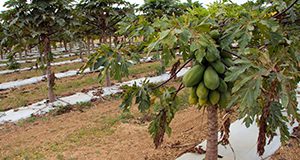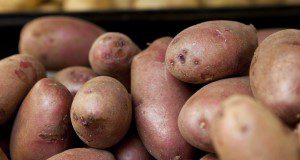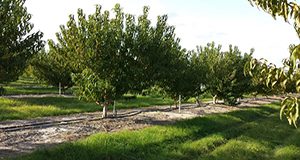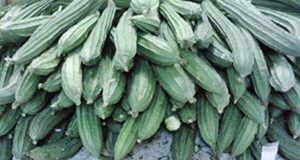Este documento provee un panorama básico de los factores más importantes al diseñar. Written by Haimanote K. Bayabil, Kati W. Migliaccio, Michael Dukes, Laura Vasquez, and Carlos Balerdi, and published by the UF/IFAS Department of Agricultural and Biological Engineering, December 2020.
https://edis.ifas.ufl.edu/ae549
Tag: Kati White Migliaccio
Programacion de Riego Basado en el Metodo de Evapotranspiracion Para Papaya (Carica papaya) en Florida
La papaya es un importante cultivo frutícola que se cultiva en el sur de Florida con un área estimada de 356 acres. Este documento se centra en las técnicas de programación de riego basadas en ET para la papaya en las condiciones de Florida. Written by Haimanote K. Bayabil, Jonathan H. Crane, Kati W. Migliaccio, Yuncong Li, Fredy Ballen, and Sandra Guzmán, and published by the UF/IFAS Department of Agricultural and Biological Engineering, November 2020.
https://edis.ifas.ufl.edu/ae547
Basic Tips for Designing Efficient Irrigation Systems
As freshwater resources become increasingly scarce and droughts become more frequent, there is a need for efficient use of water resources. Designing efficient irrigation systems and equipment will not only save money but also conserve water. This 10-page fact sheet discusses factors to consider when designing irrigation systems. Written by Haimanote K. Bayabil, Kati W. Migliaccio, Michael Dukes, and Laura Vasquez, and published by the UF/IFAS Department of Agricultural and Biological Engineering, February 2020.
https://edis.ifas.ufl.edu/ae539
ET-Based Irrigation Scheduling for Papaya (Carica papaya) in Florida
Three irrigation scheduling methods (set schedule, ET-based, and tensiometer-based) were tested for papaya production in south Florida. ET-based irrigation scheduling was found to conserve water effectively. This 6-page document primarily focuses on the ET-based irrigation scheduling techniques for papaya under Florida conditions. Written by Haimanote K. Bayabil, Jonathan H. Crane, Kati W. Migliaccio, Yuncong Li, and Fredy Ballen, and published by the UF/IFAS Department of Agricultural and Biological Engineering, March 2020.
https://edis.ifas.ufl.edu/ae540
Fertigation via Center Pivot Irrigation for Commercial Potato Production in Florida
Potatoes are an important crop in the United States, and Florida is ranked the 7th producer nationwide for potato production. In Florida, potatoes are mainly planted on sandy soils with low nutrient- and water-holding capacities. Nitrogen is the most limiting nutrient in these soils. Adopting efficient fertilization methods such as fertigation is imperative for minimizing leaching and improving use efficiency of nitrogen. This new 12-page article provides step-by-step guidelines for fertigation practices for commercial potato production. Written by Xiangju Fu, Guodong Liu, Lincoln Zotarelli, Steven Sargent, Kati Migliaccio, and Yuncong Li, and published by the UF/IFAS Horticultural Sciences Department.
https://edis.ifas.ufl.edu/hs1361
Irrigation Practices for Peaches in Florida
This 6-page document provides basic information and guidelines on water requirements and irrigation strategies for peaches grown in Florida. Written by C. Zambrano-Vaca, L. Zotarelli, K. Migliaccio, R. Beeson Jr., K. Morgan, J. Chaparro, and M. Olmstead and published by the UF/IFAS Horticultural Sciences Department, April 2018.
http://edis.ifas.ufl.edu/hs1316
How Likely Is a 100-Year Rainfall Event During the Next Ten Years?
This 4-page fact sheet describes proper interpretation of rainfall event probabilities and recurrence intervals, particularly as they are used by engineers and water resources managers in the design and construction of hydraulic structures, such as dams, levees, and canals. This article focuses on rainfall, but its explanations and concepts can be applied to other extreme hydrologic phenomena such as flood and drought. Written by Young Gu Her, William Lusher, and Kati Migliaccio, and published by the UF/IFAS Department of Agricultural and Biological Engineering, March 2018.
http://edis.ifas.ufl.edu/ae523
Florida Rainfall Data Sources and Types
This new 5-page document introduces the sources, providers, and types of rainfall data available to Florida researchers and residents to promote understanding of the rainfall data and their application in studies and daily life. Written by Meijing Zhang, Young Gu Her, Kati Migliaccio, and Clyde Fraisse, and published by the UF Department of Agricultural and Biological Engineering, January 2017.
http://edis.ifas.ufl.edu/ae517
Luffa: an Asian Vegetable Emerging in Florida
Luffa is the genus name of several tropical and subtropical plants in the cucumber family. Alternatively spelled “Loofa” or “Loofah,” the name is derived from the plant’s use as a material for sponges and dish cloths for bathing and cleaning dishes. This six page fact sheet describes the two types of Luffa, how to cultivate them, and what they can be used for. Written by Yucong Xie, Guodong Liu, Yuncong Li, and Kati Migliaccio and published by the Horticultural Sciences Department.
http://edis.ifas.ufl.edu/hs1285
SmartIrrigation Avocado App: A Step-by-Step Guide
 UF’s SmartIrrigation Avocado for iOS and Android platforms provides a simple ET-based method to schedule irrigation and is expected to provide 20% to 50% water savings based on findings with other schedule tools. This 6-page fact sheet provides configuration instructions and main menu features. Written by D. Mbabazi, K. W. Migliaccio, J. H. Crane, J. H. Debastiani Andreis, C. Fraisse, L. Zotarelli, and K. T. Morgan, and published by the UF Department of Agricultural and Biological Engineering, May 2015.
UF’s SmartIrrigation Avocado for iOS and Android platforms provides a simple ET-based method to schedule irrigation and is expected to provide 20% to 50% water savings based on findings with other schedule tools. This 6-page fact sheet provides configuration instructions and main menu features. Written by D. Mbabazi, K. W. Migliaccio, J. H. Crane, J. H. Debastiani Andreis, C. Fraisse, L. Zotarelli, and K. T. Morgan, and published by the UF Department of Agricultural and Biological Engineering, May 2015.
http://edis.ifas.ufl.edu/ae513
Smartirrigation Apps: Urban Turf
 We developed an app called Smartirrigation Turf to provide an easy-to-use mobile tool that delivers information to improve irrigation scheduling for urban turf. Using the app instead of a set time-based schedule for irrigation, homeowners and others can provide irrigation amounts to turf that more closely match water needs. This version of the app is applicable in Florida and Georgia and is available to download in the Apple App Store and Google Play Store. This 5-page fact sheet was written by K. W. Migliaccio, J. H. Debastiani Andreis, C. Fraisse, K. T. Morgan, and G. Vellidis, and published by the UF Department of Agricultural and Biological Engineering, October 2013.
We developed an app called Smartirrigation Turf to provide an easy-to-use mobile tool that delivers information to improve irrigation scheduling for urban turf. Using the app instead of a set time-based schedule for irrigation, homeowners and others can provide irrigation amounts to turf that more closely match water needs. This version of the app is applicable in Florida and Georgia and is available to download in the Apple App Store and Google Play Store. This 5-page fact sheet was written by K. W. Migliaccio, J. H. Debastiani Andreis, C. Fraisse, K. T. Morgan, and G. Vellidis, and published by the UF Department of Agricultural and Biological Engineering, October 2013.
http://edis.ifas.ufl.edu/ae499
Using Tensiometers for Vegetable Irrigation Scheduling in Miami-Dade County (ABE326/TR015)
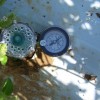 A tensiometer is a simple and relatively inexpensive tool that can be used to schedule irrigation in Miami-Dade County vegetable crops. Tensiometers continuously measure soil water potential or tension. If the tension in the soil is high, plants have to use more energy to extract soil water. If tension in the soil is low, then plants have lower energy requirements to extract soil water. This 6-page fact sheet was written by Kati W. Migliaccio, Teresa Olczyk, Yuncong Li, Rafael Muñoz-Carpena, and Tina Dispenza, and published by the UF Department of Agricultural and Biological Engineering, December 2012.
A tensiometer is a simple and relatively inexpensive tool that can be used to schedule irrigation in Miami-Dade County vegetable crops. Tensiometers continuously measure soil water potential or tension. If the tension in the soil is high, plants have to use more energy to extract soil water. If tension in the soil is low, then plants have lower energy requirements to extract soil water. This 6-page fact sheet was written by Kati W. Migliaccio, Teresa Olczyk, Yuncong Li, Rafael Muñoz-Carpena, and Tina Dispenza, and published by the UF Department of Agricultural and Biological Engineering, December 2012.
http://edis.ifas.ufl.edu/tr015
Well Installation Procedures for Agricultural Irrigation in Miami-Dade County (AE489)
 Water wells or groundwater wells are the main source of irrigation water for agriculture in Miami-Dade County. Depending on the purpose and characteristics of the well, different permits are required for installing the well and pumping water from the well. The information provided in this 4-page fact sheet is based on current rules, contacts, and prices as of March 2012 for Miami-Dade County. Written by Kati W. Migliaccio, E. Vanessa Campoverde, and Ann Marie Superchi, and published by the UF Department of Agricultural and Biological Engineering, June 2012.
Water wells or groundwater wells are the main source of irrigation water for agriculture in Miami-Dade County. Depending on the purpose and characteristics of the well, different permits are required for installing the well and pumping water from the well. The information provided in this 4-page fact sheet is based on current rules, contacts, and prices as of March 2012 for Miami-Dade County. Written by Kati W. Migliaccio, E. Vanessa Campoverde, and Ann Marie Superchi, and published by the UF Department of Agricultural and Biological Engineering, June 2012.
http://edis.ifas.ufl.edu/ae489
Interactive Urban Irrigation Tool for Florida (AE485)
A team from UF/IFAS has developed an app for optimizing your home irrigation system using real-time weather data from the Florida Automated Weather Network (FAWN). Learn more in this 5-page fact sheet written by K.W. Migliaccio, N.A. Dobbs, W.R. Lusher, J. Fan, M.D. Dukes, K.T. Morgan, and B. Ferraro, and published by the UF Department of Agricultural and Biological Engineering, March 2012.
http://edis.ifas.ufl.edu/ae485
Irrigation Scheduling for Tropical Fruit Groves in South Florida (TR001)
Irrigation scheduling can be accomplished using different tools, each with its benefits and weaknesses. It is critical to use each tool as it is intended to ensure tropical fruit trees have the irrigation water they need. This 6-page fact sheet was written by K. W. Migliaccio and Y. C. Li, and published by the UF Department of Agricultural and Biological Engineering, February 2012.
http://edis.ifas.ufl.edu/tr001
A Guide to EPA’s Numeric Nutrient Water Quality Criteria for Florida (SL316/SS528)
This revised 10-page guide provides a basic, concise, and understandable description of the United States Environmental Protection Agency’s (EPA) numeric nutrient criteria for Florida, the background events that led to its release, some pertinent scientific issues, and implications for the future. Written by Thomas Obreza, Mark Clark, Brian Boman, Tatiana Borisova, Matt Cohen, Michael Dukes, Tom Frazer, Ed Hanlon, Karl Havens, Chris Martinez, Kati Migliaccio, Sanjay Shukla, and Alan Wright, and published by the UF Department of Soil and Water Science, March 2011.
http://edis.ifas.ufl.edu/ss528
Sustainability of Agriculture in Miami-Dade County: Considering Water Supply (ABE380/AE429)
Developing sustainable agricultural practices in Miami-Dade County (Figure 1) is important to ensuring the future of its economically significant winter vegetable, tropical fruit, and ornamental nursery plant production. This 8-page fact sheet discusses water availability, factors that influence water availability, agricultural water use, and irrigation efficiency as they relate to Miami-Dade County. It was written by Kati W. Migliaccio and published by the UF Department of Agricultural and Biological Engineering, January 2011.
http://edis.ifas.ufl.edu/ae429
Evolution of water quality regulations in the United States and Florida (AE431)
Water is essential to sustain life. Not only do we all need a certain quantity of water each day, but the quality of the available water is also critical. Water quality protection in the United States evolved from initially ensuring navigability of waterways to protecting our natural ecosystems. This 5-page fact sheet provides a background for understanding water quality and how it is evaluated and regulated in the U.S. with particular focus on the state of Florida. Written by Kati W. Migliaccio, Yuncong Li, and Thomas A. Obreza. Published by the UF Department of Agricultural and Biological Engineering, January 2011.
http://edis.ifas.ufl.edu/ae431
AE456 Evapotranspiration-Based Irrigation for Agriculture: Crop Coefficients of Some Commercial Crops in Florida
AE456, a 4-page fact sheet by Isaya Kisekka, Kati W. Migliaccio, Michael D. Dukes, Jonathan H. Crane, and Bruce Schaffer, identifies typical Kc values for some of the crops commonly grown in Florida. Includes references. Published by the UF Department of Agricultural and Biological Engineering, January 2010.
http://edis.ifas.ufl.edu/AE456
AE457 Evapotranspiration-Based Irrigation Scheduling for Agriculture
AE457, a 6-page fact sheet by Isaya Kisekka, Kati W. Migliaccio, Michael D. Dukes, Jonathan H. Crane, and Bruce Schaffer, focuses on the main concepts related to ET-based irrigation scheduling and reviews the use of "smart" irrigation scheduling controllers for agricultural applications. Includes references. Published by the UF Department of Agricultural and Biological Engineering, January 2010.
http://edis.ifas.ufl.edu/AE457

